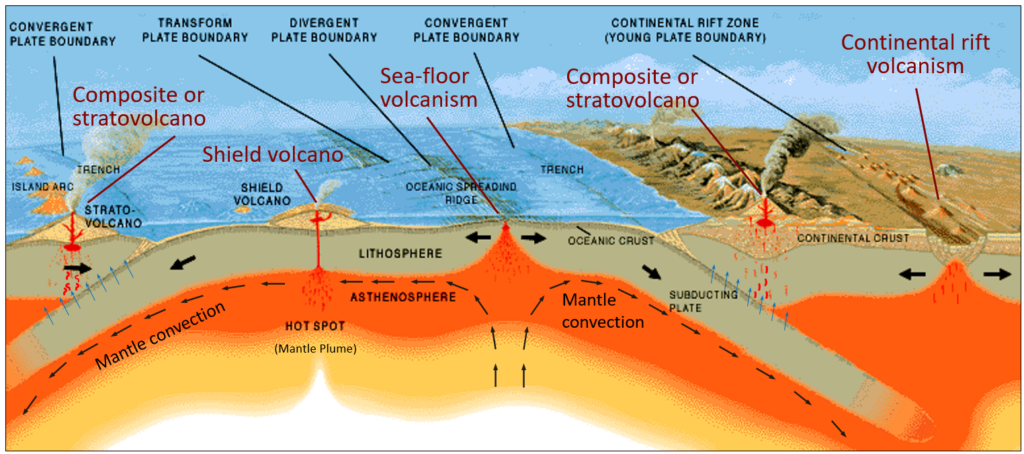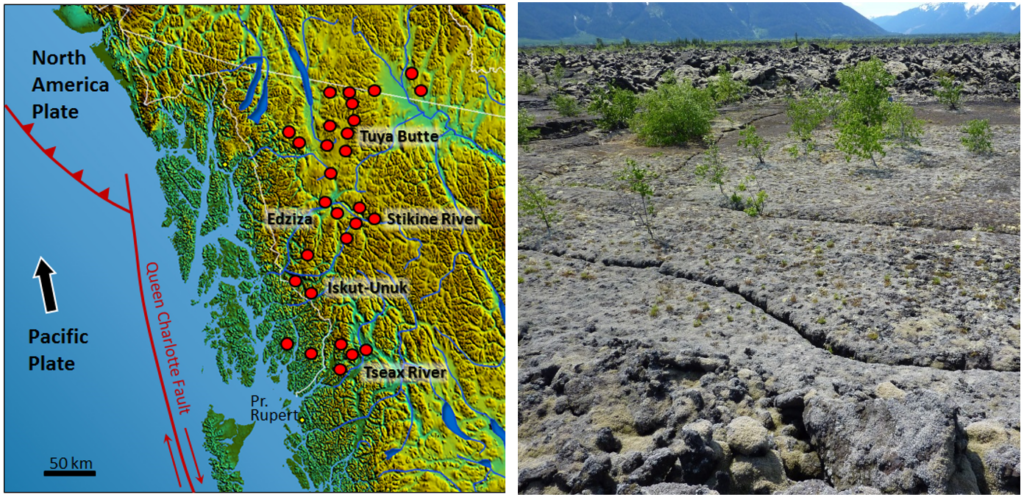7.1 Plate Tectonic Settings of Volcanism
The relationships between volcanism and plate tectonics are summarized on Figure 7.1.1. As outlined in Chapter 2, magma is formed at three main plate-tectonic settings: divergent boundaries (decompression melting), convergent boundaries (flux melting), and mantle plumes (decompression melting).

The mantle and crustal processes that take place in areas of volcanism are illustrated in a little more detail in Figure 7.1.2. At a spreading ridge hot mantle rock moves slowly upward by convection (cm/year) and within about 60 km of surface partial melting starts because of decompression. Over the triangular area shown on Figure 7.1.2a about 10% of the ultramafic mantle rock melts, producing mafic magma that moves upward toward the axis of spreading (where the two plates are moving away from each other). The magma fills vertical fractures produced by the spreading, and it spills out on the sea floor to form basaltic pillows (more on that later) and lava flows. There is spreading-ridge volcanism taking place about 200 km offshore from the west coast of Vancouver Island.

At an ocean-continent or ocean-ocean convergent boundary oceanic crust is pushed down into the mantle (Figure 7.1.2b).[1] It gets heated up, and while there isn’t enough heat to melt the relatively cool subducting oceanic crust, there is enough to force the water out of some of its minerals (especially the sheet-silicate mineral serpentine). This water rises into the overlying mantle where it contributes to flux melting of the already hot ultramafic mantle rock. The mafic magma produced rises through the mantle to the base of the crust. There it contributes to partial melting of crustal rock, and that makes the magma more felsic than it was to begin with. That magma continues to rise and to assimilate crustal material, and in the upper part of the crust it accumulates within magma chambers. From time to time some of the magma from the plutons is forced up to surface, leading to volcanic eruptions. Washington State’s Mt. St. Helens, which last erupted in the 1980s, is an example of subduction-related volcanism.
A mantle plume is an ascending column of hot mantle rock (not magma) that originates deep in the mantle, possibly just above the core-mantle boundary. Mantle plumes are thought to rise at between 5 and 10 times the rate of mantle convection. The ascending column may be in the order of tens of kilometres to over a hundred kilometres across,[2] but near to the surface it spreads out to create a mushroom-style head (Figure 7.1.2c). Near to the base of the lithosphere (the rigid part of the mantle) the mantle plume (and possibly some of the surrounding mantle material) partially melts to form mafic magma that rises to feed volcanoes. Since most mantle plumes are situated beneath the oceans, the early stages of volcanism typically take place on the sea floor. Over time islands may form like those in Hawaii.
Exercise 7.1 How Thick is the Oceanic Crust?
Figure 7.1.2a shows a triangular zone about 60 km thick, within which approximately 10% of the mantle rock melts to form oceanic crust. Based on this information, roughly how thick do you think the resulting oceanic crust should be?
Exercise answers are provided Appendix 2
Not all volcanic regions fit nicely into these three categories, and one of these exceptions is the volcanism in northwestern British Columbia (Figure 7.1.3). This area is not at a divergent or convergent boundary, and there is no evidence of an underlying mantle plume. The prevailing theory is that the crust of northwestern BC is being stressed by the northward movement of the Pacific Plate against the North America Plate, and that the resulting crustal fracturing provides a conduit for the flow of magma from the asthenospheric mantle.[3]

Media Attributions
- Figure 7.1.1 Steven Earle, CC BY 4.0, after a Public Domain drawing, Dynamic Planet, section by J. Vigil, from US Geological Survey, http://pubs.usgs.gov/gip/dynamic/Vigil.html
- Figure 7.1.2 Steven Earle, CC BY 4.0, after a Public Domain drawing, Dynamic Planet, section by J. Vigil, from US Geological Survey, http://pubs.usgs.gov/gip/dynamic/Vigil.html
- Figure 7.1.3 Map modified by Steven Earle, CC BY 4.0; from base map, South-West Canada, public domain by Qyd/US Geological Survey, ESRI GIS data via Wikimedia Commons, http://commons.wikimedia.org/wiki/File:South-West_Canada.jpg; Volcanic locations (data) from Edwards & Russell (2000); Photo on right by Steven Earle, CC BY 4.0
- At an ocean-continent convergent boundary part of a plate that is made up of oceanic crust is subducting beneath part of another plate made up of continental crust. At an ocean-ocean convergent boundary one ocean-crust plate is being subducted beneath another ocean-crust plate. ↵
- Steinberger, B. and Antretter, M. (2006). Conduit diameter and buoyant rising speed of mantle plumes: implications for the motion of hot spots and shape of plume conduits. Geochemistry, Geophysics, Geosystems, 7(11). https://doi.org/10.1029/2006GC001409 ↵
- Edwards, B. & Russell, J. (2000). Distribution, nature, and origin of Neogene-Quaternary magmatism in the northern Cordilleran volcanic province, Canada. Geological Society of America Bulletin, 112(8), 1280-1293. https://doi.org/10.1130/0016-7606(2000)112<1280:DNAOON>2.0.CO;2 ↵
